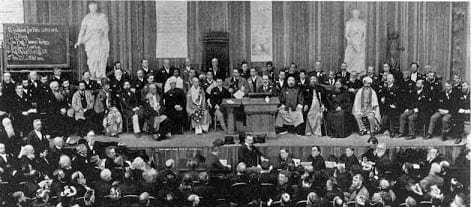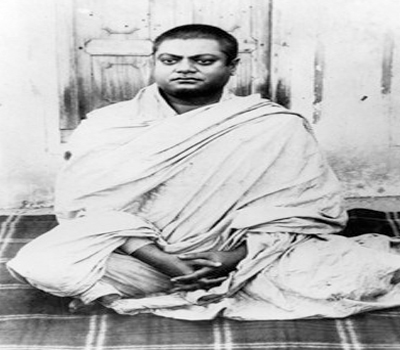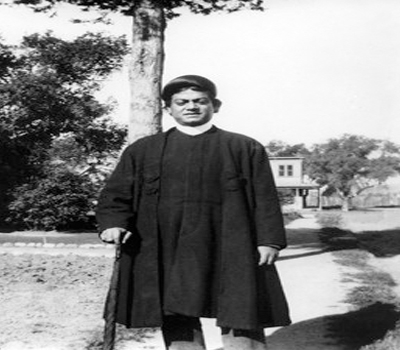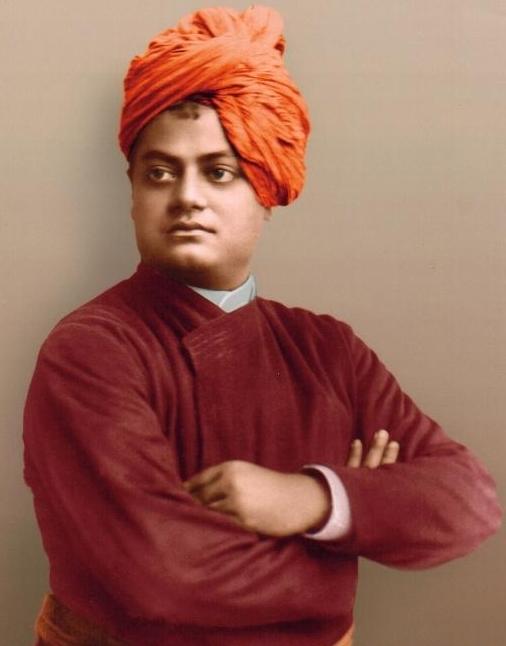ONE DAY THE DIVINE MOTHER showed Ramakrishna a vision of Keshabchandra Sen and his followers. Keshab was telling his disciples: ‘Please listen to what he [meaning the Master] is saying.’ Ramakrishna then said to the Divine Mother: ‘Mother, these people hold the views of “Englishmen”. Why should I talk to them?’ Th e Mother replied that ‘it would be like this in the Kaliyuga’.1
Stockpile of Spiritual Power
As Swami Saradananda later said, Ramakrishna understood that everything happens according to the will of the Divine Mother, so he did not get upset about this. Moreover, the Master had earlier ‘realized the dearth of spirituality in the world’ and had also come to understand that ‘the [Divine] Mother’s grace had given him a stockpile of extraordinary spiritual power to be used in removing that want’. 2 Eventually, after talking to Keshab and his followers for a few years, Ramakrishna became familiar with their way of thinking. So when Swami Vivekananda, as the young Narendranath, fi rst came to him, he was not surprised to find that the young man also held such views.
What is amazing though is how Ramakrishna trained this young disciple. And what is also amazing is how Swamiji kept coming back for that training. Two souls so close that they were actually one, yet for all appearances they were so different. In those days Swamiji was inexorable in the way he viewed things. He firmly believed that his Western-like way of thinking was right and the old Indian traditions were wrong—even superstitious.
Yet Ramakrishna never tried to convince Swamiji otherwise. Rather, he always steered him towards another way of looking at things. Thus, when Swamiji’s training under the Master was over, Swamiji’s Western outlook was not destroyed, but was broadened and deepened by the ancient Indian heritage. This was a heritage that had been lived in toto by the Master him-self—yet lived with a Western scientific outlook that demanded verification every step of the way. ‘Wonderful is the expounder and rare the hearer; rare indeed is the experiencer of Atman taught by an able preceptor.’3
Through his amazing sadhanas and realizations, Ramakrishna had not only proved that God exists and can be realized in a superconscious state, but he had also deepened and expanded the common notion of what ‘religion’ is. He had proved that all religious paths—even those of foreigners—were paths to God. He had shown that religion is not just a set of doctrines and dogmas or rituals. It does not lie in a particular scripture or prophet or saviour. Rather, religion is the whole soul yearning for God, yearning to realize its oneness with God. And one may call that God—Him or Her—by whatever name one likes. In India these ideas had been there for thousands of years, but they had become more and more buried under sectarian feuds. What Ramakrishna did was to put the ideas of ‘As many faiths, so many paths’ and of the divinity of human beings into the subtle thought current through his ‘stockpile of extraordinary spiritual power’.
So the ideas were there in the subtle realm, but he needed a person—a ‘voice’—to speak those ideas in modern terminolog y to the science-dominated sceptical world. This ‘voice’ was Swamiji. And once that voice spoke—once those ideas came out of the subtle realm—what amazing power burst forth! We can probably say that Swamiji also completely changed the way people of the West think about religion. And he did this, not by tearing down people’s ideas of religion, but by broadening and deepening them.
Vivekananda’s Love for Christ
As the people of the West were in those days mainly Christians, Swamiji often built a foundation on his knowledge of Christ and Christ’s teachings. In a letter dated 20 August 1893 to Alasinga Perumal—a letter written before the Parliament of Religions convened—Swamiji said: ‘Know, then, that this is the land of Christians, and any other influence than that is almost zero. … I am here amongst the children of the Son of Mary, and the Lord Jesus will help me. They like much the broad views of Hinduism and my love for the Prophet of Nazareth. I tell them that I preach nothing against the Great One of Galilee. I only ask the Christians to take in the Great Ones of Ind along with the Lord Jesus and they appreciate it.’4
Swamiji was, in fact, very devoted to Christ. While he was at the Baranagore Math, he translated part of The Imitation of Christ, by Thomas à Kempis, into Bengali and also wrote some notes and a beautiful introduction to it. He also carried a copy of this book with him when he was on pilgrimage. Once, when asked about his feelings for Jesus, Swamiji replied: ‘Had I lived in Palestine, in the days of Jesus of Nazareth, I would have washed his feet, not with my tears, but with my heart’s blood’ (9.423).
What made him so devoted to Christ? We can possibly get an answer to this question by taking a look at a lecture he gave in Los Angeles in January 1900 entitled ‘Christ, the Messenger’. On close examination one might wonder, ‘Is Swamiji talking here about Christ or about Ramakrishna?’ I think we can truly say that he is talking about both of them, as everything he says fits both. To Swamiji, Christ and Ramakrishna were the same. And just as the disciples of Christ lived with their Master, imbibed his teachings, and received from him divine power to preach his message, so also did Swamiji.
Swamiji’s feelings for Christ thus placed him on solid ground in Western countries. After all, who could argue with someone who had such devotion to Christ? And who could argue with someone whose knowledge of the Bible and of Judeo-Christian history was second to none? Yet Swamiji was not blind to the flaws of the Christians of those days—especially to their exclusivism and emphasis on sin. Both of these points he hit upon immediately at the Parliament of Religions and also later, wherever he lectured in the West. And both of these points gave him the leverage he needed to present in detail the Vedantic conceptions of God, the human being, and religion itself.
But having deep love for Christ was not Swamiji’s only qualification for his work in the West. He had, in fact, deep love for all religions. His love was for the essence of religion itself, and it was not hard for those who met him to feel that. As he said, ‘If one religion be true, then all the others also must be true’ (1.x). Moreover, as mentioned before, his whole mindset was geared towards a Western scientific way of thinking. And he also had an almost insatiable hunger for learning—whether the subject was science, philosophy, poetry, music, or anything else. If we look at Swamiji’s ‘Paper on Hinduism’, delivered at the Parliament of Religions on 19 September 1893, we can see the brilliant way in which he presented Vedantic ideas to the doubting Western mind.
Almost at the very beginning of this talk Swamiji presented the Hindu idea of creation in terms of Western science:
The Vedas teach us that creation is without beginning or end. Science is said to have proved that the sum total of cosmic energy is always the same. Th en, if there was a time when nothing existed, where was all this manifested energy? Some say it was in a potential form in God. In that case God is sometimes potential and sometimes kinetic, which would make Him mutable. Everything mutable is a compound, and everything compound must undergo that change which is called destruction. So God would die, which is absurd. Therefore there never was a time when there was no creation (1.7).
Swamiji then goes on to discuss the Vedantic idea of the human being—that a human being is not the body but the spirit living within the body—and how the idea of reincarnation agrees with science, more so than the theories of heredity and instinct. And along with the idea that the human being is spirit, Swamiji presents the Vedantic idea of the soul being divine: ‘“Children of immortal bliss”—what a sweet, what a hopeful name! Allow me to call you, brethren, by that sweet name—heirs of immortal bliss—yea, the Hindu refuses to call you sinners. Ye are the Children of God, the sharers of immortal bliss, holy and perfect beings. Ye divinities on earth—sinners! It is a sin to call man so; it is a standing libel on human nature (1.11).
The Non-dual Aspect of Vedanta
After Swamiji describes some basic tenets of Hinduism—the divinity of the soul, the attainment of liberation, and loving God for love’s sake—he then goes on to explain the non-dual aspect of Vedanta, again in terms of science:
And so when a soul becomes perfect and absolute, it must become one with Brahman, and it would only realise the Lord as the perfection, the reality, of its own nature and existence, the existence absolute, knowledge absolute, and bliss absolute. …
Therefore, to gain this infi nite universal individuality, this miserable little prison-individuality must go. Then alone can death cease when I am one with life, then alone can misery cease when I am one with happiness itself, then alone can all errors cease when I am one with knowledge itself; and this is the necessary scientific conclusion. Science has proved to me that physical individuality is a delusion, that really my body is one little continuously changing body in an unbroken ocean of matter; and Advaita (unity) is the necessary conclusion with my other counterpart, soul.
Science is nothing but the finding of unity (1.13–4).
From the heights of Advaita Swamiji then proceeds to show how all forms of worship—from idolatry to Advaita—are in reality worshipping that one divine Being. Yet, he says, the Hindu does not stop with ‘an intellectual assent to certain doctrines and doing good to their fellows,’ but rather ‘the whole religion of the Hindu is centred in realisation. Man is to become divine by realising the divine’ (1.16).
And from there Swamiji shows how all religions are true, how they are all leading people to the same goal:
Unity in variety is the plan of nature, and the Hindu has recognised it. Every other religion lays down certain fixed dogmas, and tries to force society to adopt them. … The Hindus have discovered that the absolute can only be realised, or thought of, or stated, through the relative, and the images, crosses, and crescents are simply so many symbols—so many pegs to hang the spiritual ideas on. It is not that this help is necessary for every one, but those that do not need it have no right to say that it is wrong. Nor is it compulsory in Hinduism. …
To the Hindu, then, the whole world of religions is only a travelling, a coming up, of different men and women, through various conditions and circumstances, to the same goal.
Every religion is only evolving a God out of the material man, and the same God is the inspirer of all of them (1.17–8).
After the Parliament of Religions Swamiji carried on his work in the West in much the same way as he had at the parliament itself. In his lectures he quoted from the Bible as well as from Western science, philosophers, poets, and other writers. And his lectures and classes consisted mainly of introducing the ideas of the divinity of the soul and the existence of one divine Consciousness that pervades the whole universe, as well as promoting the idea that all religions are paths to God. Swamiji knew that if these ideas could enter the minds of the people of the West, then this would be of great benefit to the whole world.
But he added something more in his private classes. There he also introduced the concept of a daily spiritual practice for the realization of God—particularly through the practice of raja yoga. This also was new to most Westerners.
The West after Swamiji
Most likely, no one in the West before Swamiji had attempted to use science to prove conclusions of religion in the way he did. This was new and it was daring. But so also were the many intellectual challenges he threw out to the American people regarding their ideas of religion. And inspite of heavy opposition from some of the clerg y, the seeds Swamiji planted fell on fertile ground. Knowingly or unknowingly the American people took it in. Yet for years the seeds lay quietly underneath the surface.
Then came the 1960s. It was as if a whole paradigm shift had suddenly taken place in the West. Everything about India became a fad, and young people flocked there to find enlightenment or a guru or something, they knew not what. Others gathered around the gurus, babajis, swamis, yogis, rishis, lamas, and others, who began settling in every major city of the West. The translation of the Bhagavadgita by Swami Prabhavananda and Christopher Isherwood sold over a million copies. Religious studies programmes opened up in one university after another—and they included religions of South Asia in their programmes. People were no longer afraid to speak openly of reincarnation, and words like ‘karma’, ‘avatar’, and ‘guru’ began to be used in common parlance. All this seemed to have come out of nowhere. But those who knew of Swamiji understood that the seeds he planted were beginning to sprout.
Since then the scepticism regarding God and religion that had overtaken the West so strongly a hundred years earlier has become hardly an issue. Many are openly acknowledging the divinity within all beings. In fact, ‘we are all one’ seems to be the mantra for this age. People are also taking their relationship with God seriously, whether they are affiliated with a particular religion or not. Rather, they oft en describe themselves as ‘spiritual’ instead of ‘religious’, as they prefer to go beyond the perceived dividing lines of religion.
Again, inter-religious councils have been convened in almost all the major cities so that people of all faiths can regularly get together and learn about each other’s teachings. Though fundamentalism among many religious groups has become more visible—sometimes taking a violent turn—this is most likely a reaction to the fact that more and more people are becoming liberal in their outlook towards other religions.
And amazingly, Swamiji’s dream that ‘science and religion will meet and shake hands’ (2.140) is, in a sense, literally coming true now with frequent dialogues, seminars, and conferences being held all over the world between scientists, doctors, and religious people. Meditation also is becoming a part of life for many people in the West, though it is not always done for the realization of God. It is even being incorporated into busy work schedules in some companies, as people understand its benefits for the relief of stress. America takes things in its own way, but it is changing. Aft er all, the sprouts are only beginning to come up.
The people of India have long considered Swamiji to be the awakener of India. But those people in the West who know of him feel that he was also the awakener of the West. Swamiji himself said: ‘I have a message to the West as Buddha had a message to the East’ (5.314). More than a hundred years have passed since he fi rst came to the US, and we now find that all the major ideas he preached—the ideas that entered the minds of those fortunate people to whom he spoke—have indeed entered the very thought current of the West. And some people are just now beginning to understand where it all came from.
We have given here a few facets of Swamiji’s philosophy and personality that contributed to his success in the West and made him the perfect ambassador from the East to the West. But there are many more such facets of Swamiji that cannot be covered here. And even if it were possible for all of them to be enumerated, it would still not give us a complete picture of what exactly he did. As with other aspects of the spiritual realm, the sum of all the parts together still does not make a whole. Swamiji himself added something else that was much, much vaster and sublime than what we can possibly fathom.
(Source: Prabuddha Bharatha January 2013)
References
1�. M, The Gospel of Sri Ramakrishna, trans. Swami Nikhilananda (Chennai: Ramakrishna Math, 2002����), 83I���.
2�. Swami Saradananda, Sri Ramakrishna and His Divine Play, trans. Swami Chetanananda (St Louis: Vedanta Society of St Louis, 2003����), 649���.
3�. Katha Upanishad 1.2�.7�, in The Upanishads, 4� vols, trans. Swami Nikhilananda (Kolkata: Advaita Ashrama, 2008����), I�.I33.
4�. The Complete Works of Swami Vivekananda, �9 vols (Calcutta: Advaita Ashrama, �I-8, 1989; 9,1997) 5.I2-I3.
Related







Leave A Comment